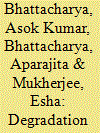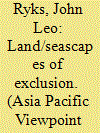|
|
|
Sort Order |
|
|
|
Items / Page
|
|
|
|
|
|
|
| Srl | Item |
| 1 |
ID:
133700


|
|
|
|
|
| Publication |
2014.
|
| Summary/Abstract |
Sandy beaches along the 220km long West Bengal coast on the Northwest coast of the Bay of Bengal have not received much attention in the recent past despite their continual degradation both from natural forces and man-made activities related to construction of hotels, destruction of sand dunes and dune vegetation, beach- sand mining, discharge of hotel wastes directly onto the beach, and unscientific beach protection measures (Bhattacharya et al., 2003, Bhattacharya etal. 2009). Unethical and rampant use of this coastal zone by hoteliers, often violating the Coastal Zone Regulations (CRZ), has been vandalizing certain beach stretches for over two decades now. (wvvw. Dishaearth.org./mandarmoni). Burgeoning population growth in the state is causing increasing use of beaches for pleasure, recreation, and leisure activities throughout the year. Together with this, as pointed out by Klein (1985), beaches support coastal economics, commercial development, tourism and shift of population to the coastal areas.
|
|
|
|
|
|
|
|
|
|
|
|
|
|
|
|
| 2 |
ID:
132405


|
|
|
|
|
| Publication |
2014.
|
| Summary/Abstract |
This paper describes how the transformation of coastal New Zealand is directly connected to the dislocation and marginalisation of many M?ori coastal communities. It focuses on how this transformation is played out in text and talk and how certain types of boundaries function as important determinants in the construction and social order of coastal New Zealand. The high value and demand placed on specific, accessible 'cadastral' parcels of private coastal property dictates that much of New Zealand's coast is mapped according to constructs of wealth and desirability. In other parts of the country where development pressures on the coast are less prevalent, coastal communities are less evidently connected to markers of affluence and/or 'whiteness'. In these less disciplined spaces, uncertainty and liminality is more influential in the making of coastal places. Through an analysis of interviews with coastal planners and residents of coastal communities it is revealed that particular hegemonies, through the discourses they produce, attempt to assert a particular socio-spatial epistemology on counter-hegemonic groups in an effort to develop and manage the coast. Communities that revealed an alternative social ordering are described as messy and difficult to manage, while other coastal communities are marketed as exclusive, where model residents inhabit model places.
|
|
|
|
|
|
|
|
|
|
|
|
|
|
|
|
|
|
|
|
|